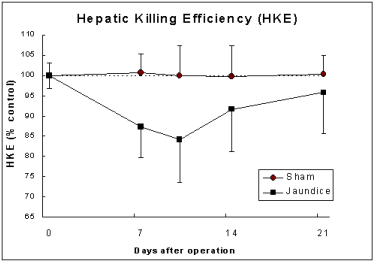# 100927 Abstract ID: 100927 Biliary Obstruction Reduces Hepatic Killing as Well as Phagocytic Clearance of Circulating Microorganism in Rat
Sumito Hoshino, Zhaoli Sun, Keiichiro Uchikura, Eugene Ceppa, Gregory B Bulkley, Andrew S Klein, Baltimore, MD
Background: Septic complications are common in patients with biliary obstruction. This is thought to be related, in part, to dysfunction of the hepatic reticuloendothelial system (RES). It has been reported that nearly 80% of circulating microorganisms are phagocytosed and killed within the liver. Although clearance of pathogens is significantly impaired in jaundiced patients, the effect of biliary obstruction specifically upon hepatic phagocytic killing is less well described. This study was designed to quantify the effect of biliary obstruction, simultaneously and discriminately, on two important components of hepatic RES function (phagocytosis and phagocytic killing). Methods: Rats were divided into three experimental groups: control animals (no laparotomy), sham animals (laparotomy only), jaundiced animals (laparotomy with common bile duct ligation (CBDL)). At 7, 10, 14, and 21 days after operation, E.coli labeled with both 125I and 51Cr were injected intravenously into the rats. Using the previously validated double-labeled in vivo E. coli clearance technique, hepatic phagocytic clearance (HPC), hepatic killing efficiency (HKE), and net hepatic killing (NHK) were measured. Results: CBDL resulted in a significant decrease in the HPC of E. coli 10, 14, and 21 days post-operatively, when compared with sham or control animals. Similarly, HKE was significantly decreased in jaundiced animals by postoperative day 10, but returned to baseline values by day 14. The net effect of these changes in HPC and HKE were reflected in a significant reduction in NHK in jaundiced animals when compared to sham or control animals, suggesting that more bacteria remained viable within the liver. Conclusion: The present study suggests that obstructive jaundice impairs both phagocytosis and phagocytic killing within the liver. These findings may help to explain the susceptibility of patients with biliary tract obstruction to the morbidity and mortality of septic complications.

|
 500 Cummings Center
500 Cummings Center +1 978-927-8330
+1 978-927-8330
 +1 978-524-0461
+1 978-524-0461